Inside The Coolest New Luxury Hotel In Venice
The hip waterfront oasis features world-class design, cuisine and cocktails in the heart of Venice, Italy.
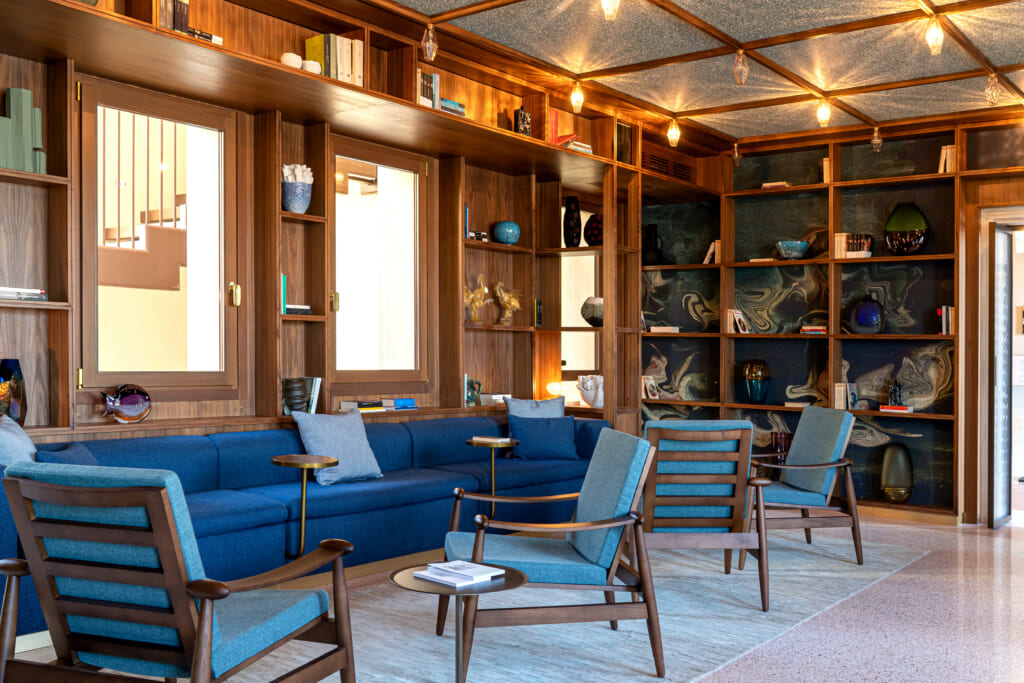
As renowned luxury-travel industry expert Geoffrey Weill notes, “In a city [like Venice] where everything from a hovel to a palazzo is a precious landmark, converting a 13th-century hostel into a five-star hotel requires months and years of inspections, favors, permissions, fawning, licenses, court judgements, more inspections, and grudging approvals.”
When by a seeming miracle the stars align and it is possible to effect such a transformation, it’s a cause for celebration—and for booking the next flight to Italy. Which is exactly what we did upon hearing of the opening of Ca’ di Dio.
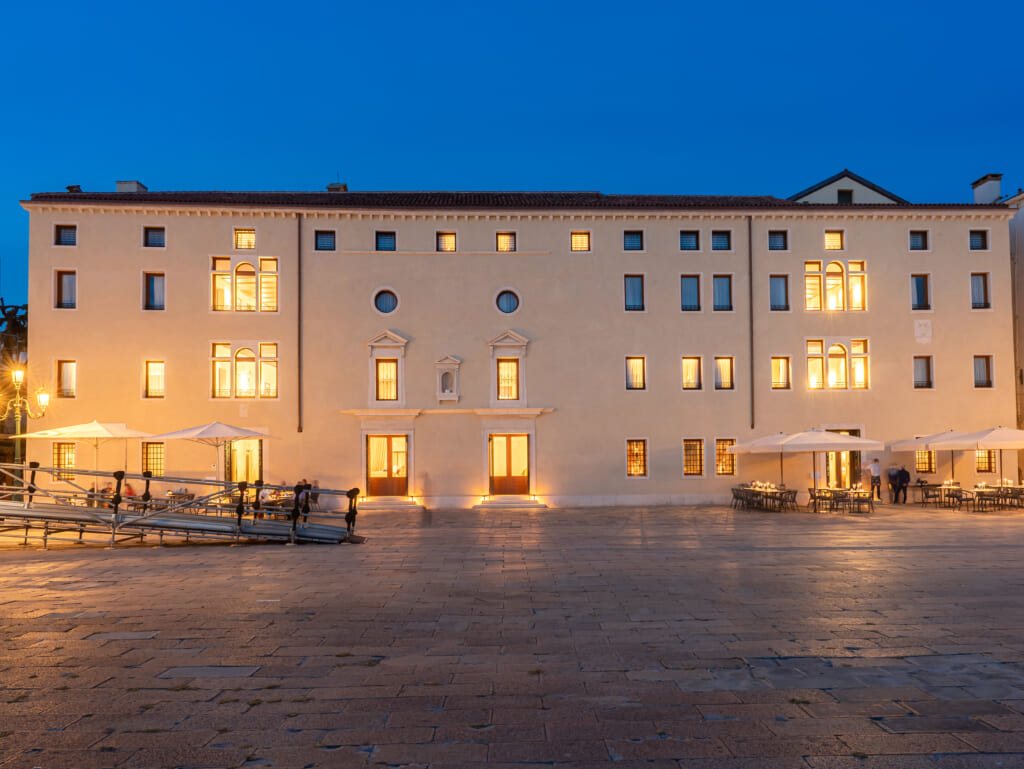
Part of the posh VRetreats portfolio, Ca’ di Dio is designed as an elegant, urban and quintessentially Venetian retreat “that captures the spirit of the city and blends its history with modernity,” a fitting addition to the VRetreats collection of “timelessly beautiful residences and palaces, charming and evocative locations characterized by unconventional luxury and an intimate atmosphere in which to enjoy warm Italian hospitality.”
Overlooking St. Mark’s Basin, Ca’ di Dio is close to the heart of the ancient city of Venice, but separated from the main crush of tourists.
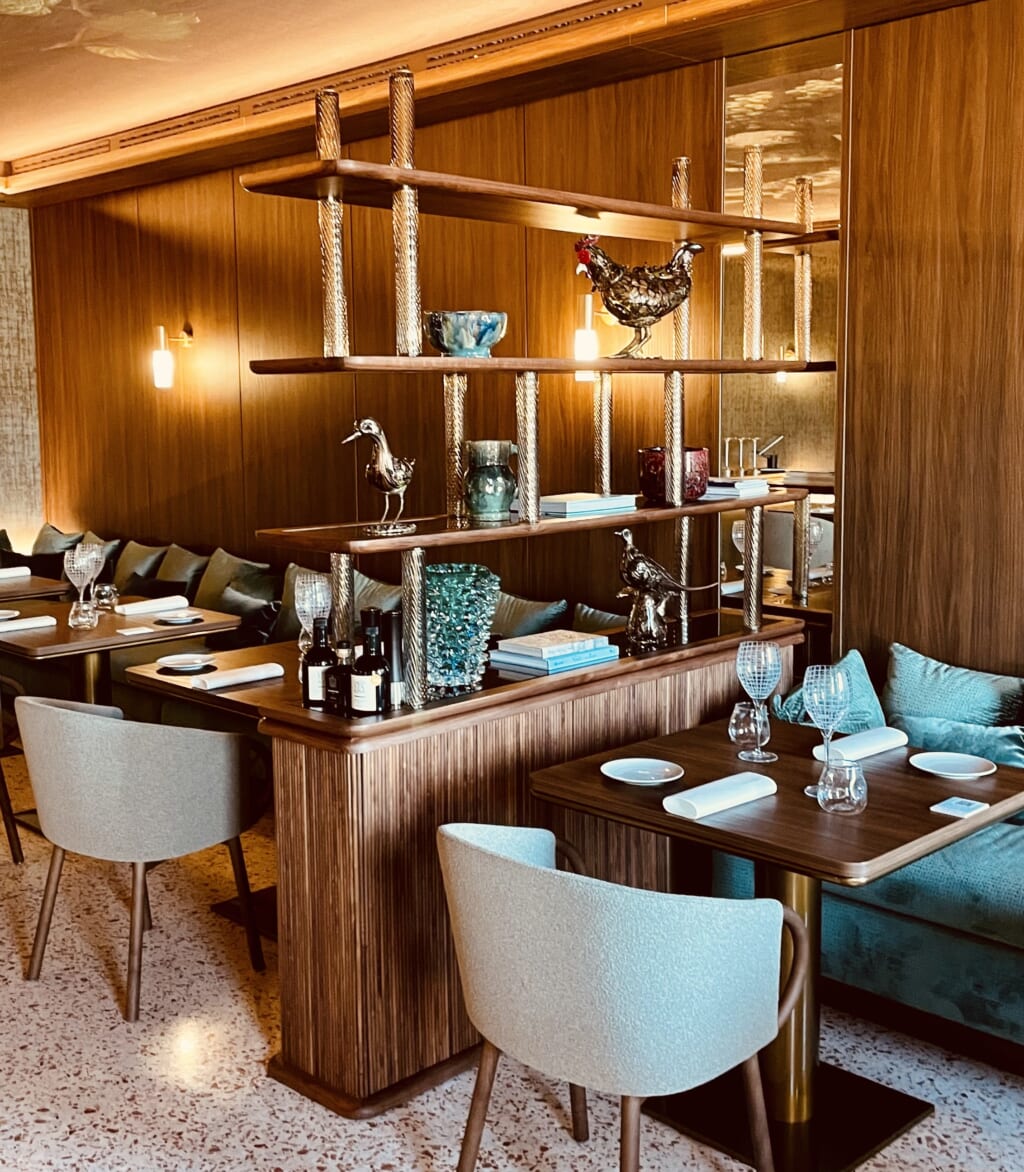
It is largely the vision of Christophe Mercier, the property’s stylish and talented General Manager, who has led the Ca’ di Dio project from its preliminary stages. Mercier has over a quarter-century’s experience in luxury hospitality, and his portfolio includes icons like the Palace Hotel in San Francisco, the Prince de Galles in Paris, and the Hotel Danieli, Gritti Palace, and San Clemente Palace in Venice, the city’s finest grand luxe hotels.
He also happens to be an accomplished expert in architecture and design. “Ca’ di Dio encompasses what I call venessentia—that is, the fascination, atmosphere and the most intimate essence of Venice,” he says.
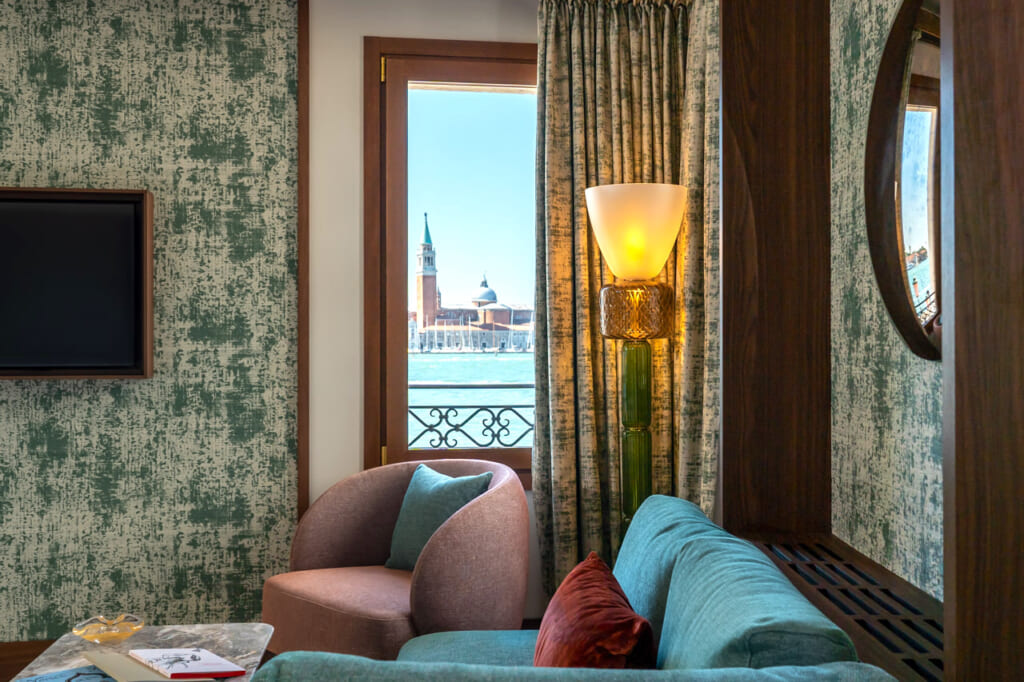
“I would like every guest to feel at home, in the heart of the city, but in an area protected from the more frenetic tourist routes,” Mercier states, an important distinction in a small city which attracts millions of visitors every year. “We are next to the Biennale”—in the cool Contemporary Art District—with an incredible view of San Giorgio [island] and a generous outdoor space.
With more than 400 windows, two rooftop loggias, and three gardens, Ca’ di Dio is really a window onto beauty and in constant dialogue with one of the most beautiful cities in the world.”
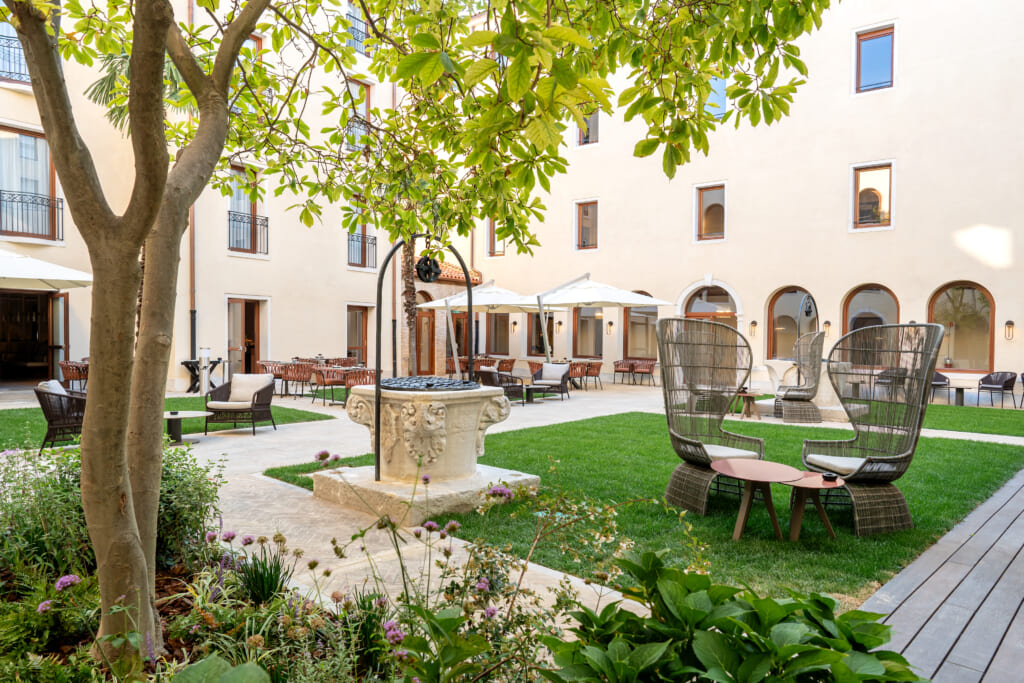
Originally constructed in 1272, Ca’ di Dio’s incredible architecture and history infuses the building throughout. Yet it is also totally contemporary thanks to a restoration and updates overseen by famed Spanish architect and designer Patricia Urquiola.
The project was founded on two objectives, VRetreats notes: “To enhance the ancient structure and allow guests to discover the most authentic Venice while within its walls,” while creating a wholly unique and new experience that cannot be replicated anywhere else. Geoffrey Weill describes the end result as “sumptuous… although it’s a sumptuousness of style rather than ostentation”—which is much harder to create than mere opulence, we’d say. Ca’ di Dio also manages to be a model of sustainability and eco-friendly operation.
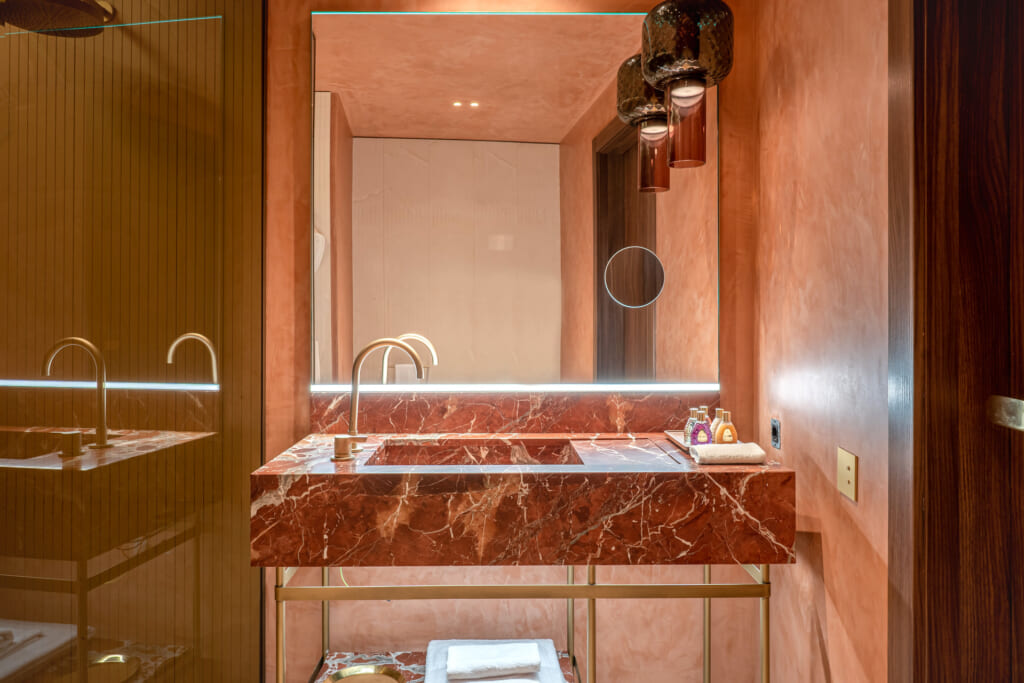
Additionally, a concept that “deeply links Ca’ di Dio to the very fabric of the city of Venice is reflected in the materials selected” for its renaissance—glass, wood, wrought iron, stone and marble, as well as “the color palette, and the meticulous attention to details,” as the hotel puts it. “Each element is the work of the skilled hands of local artisans, who shaped the furnishings, fabrics, and decorations by combining a passion for their work with the secrets and techniques of Venetian tradition.”
Mercier Urquiola commissioned each decorative element specifically for the hotel, and he personally and meticulously oversaw, and in some cases even participated in, the creation of everything from the barware to the bedposts, all completely bespoke.
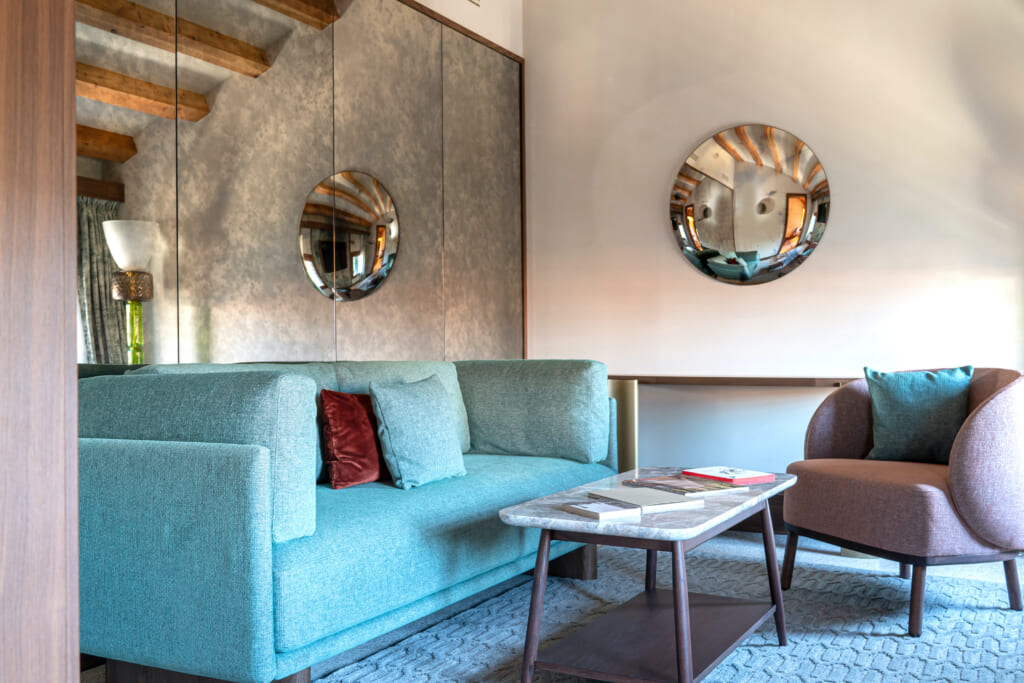
“Ca’ di Dio is not a hotel but a Venetian house,” Mercier declares, pointing out that most recently in its impressive history, it was a private mansion. “We welcome you as if you were visiting an elegant Venetian friend. For me, elegance is about education and attention to detail, versus luxury, which is about price.”
Rather than merely a hotel to be visited, Ca ‘di Dio “is an experience to be lived,” he says. “Our guests will be able to touch the charm of this timeless home. The bright travertine in the public rooms, the perfectly-preserved frescoes, the Murano glass details, and the Istrian stone that surrounds the architecture are not just details, but real emotions. ”
Urquiola’s mission can be best described as “rebirth, restoration, redesign.” As Weill points out, it’s all incredibly alluring in its subtle yet extreme beauty. “Everything is oriented towards shades and nuances, rather than true colors,” as the hotel puts it, “transparencies that recall the reflections of water”—another key, recurring theme at Ca’ di Dio, which of course has a “water gate” for the iconic water taxis that ply the canals of Venice.
Overall, “the color palette is sober and soft, with shades and transparencies in a fluid play of continuous movements, just like water. The idea is to contrast and combine the Venice of the sconte, hidden streets made of old bricks, with the Venice of the noble palaces with marble and elaborate decorations.”
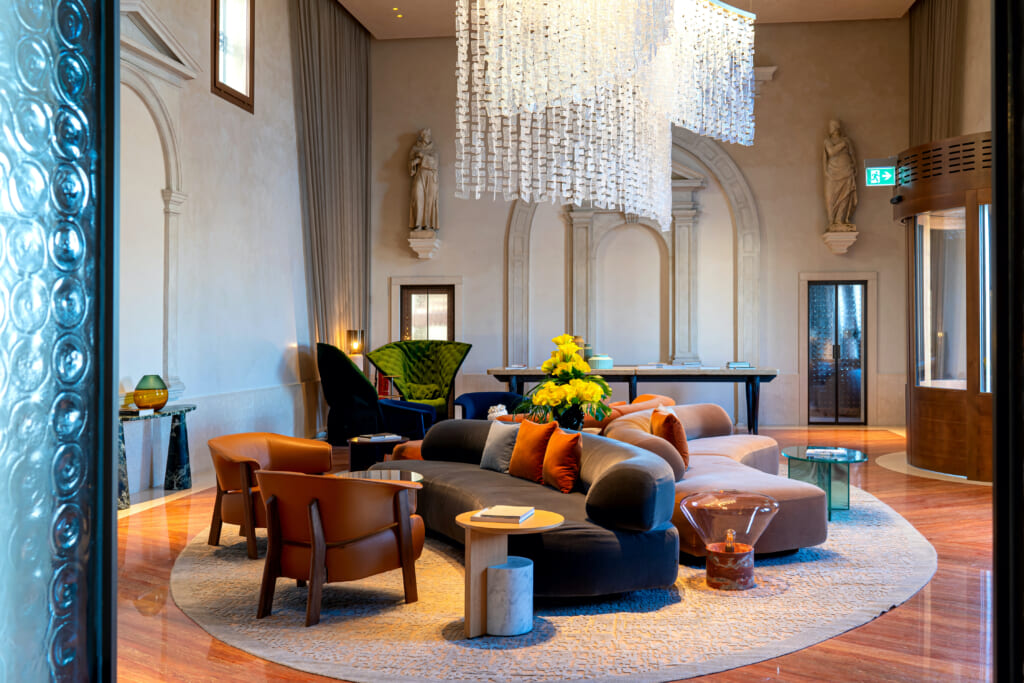
The lobby was created from the historic church that once occupied the center of the site, and is illuminated by a chandelier made of over 14,000 Murano glass crystals—created entirely by hand according to the city’s legendary glassmaking tradition, and “designed to reproduce three sails that reflect the shape and sinuous movement of the seating below.”
Off of the quietly magnificent lobby is a soothing library and reading room “where guests can retreat to find a moment of intimacy and privacy,” as well as the enclosed main courtyard, which in warmer months is the perfect place for a snack or a drink should you not be in the mood for the waterfront tables outside the hotel’s entrance.
There is also an intimate Pura Spa featuring treatments and products by local brand The Merchant of Venice, developed on the basis of fragrances, raw materials and essential oils from “ancient recipes imported over the centuries in the lagoon city by its merchants.”
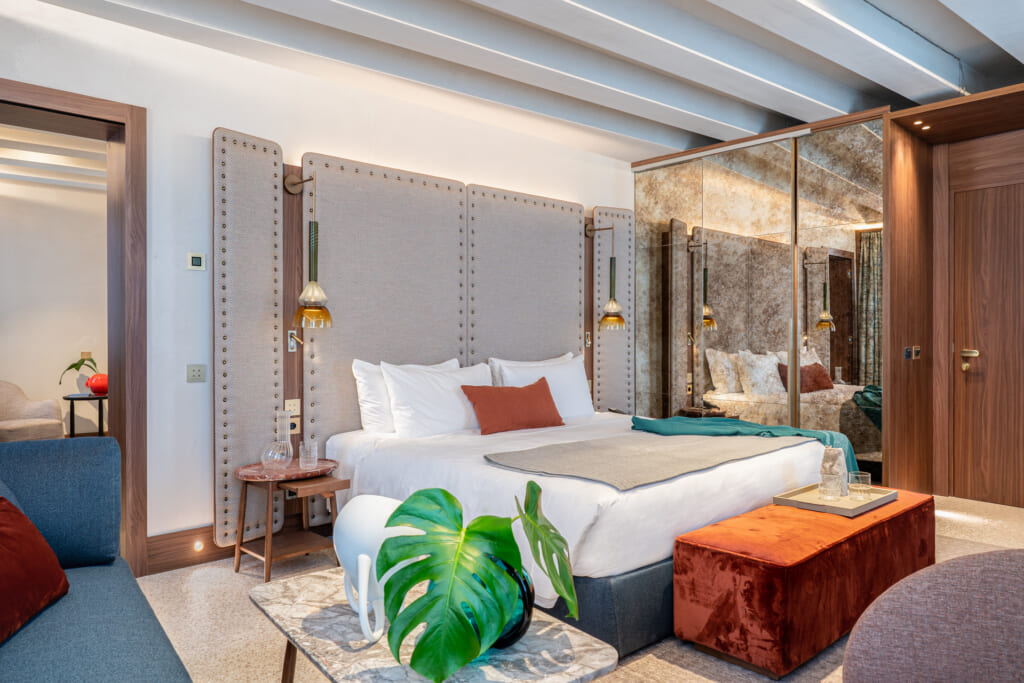
The hotel’s upper floors are home to 57 suites and nine Deluxe rooms, carrying over the design concepts of the public spaces, but in a more intimate manner. There’s an emphasis on “continuity and relevance” to the windows onto the city, and the relationship between the rooms and their surroundings.
Again, all the fixtures, furnishings and decorative elements are bespoke, made locally and by hand. Each room and suite offers a unique view, “from the incomparable panorama of the splendor of St. Mark’s Basin,” to the view of the island of San Giorgio Maggiore, up to the Rio of Ca’ di Dio, and the internal courtyards.
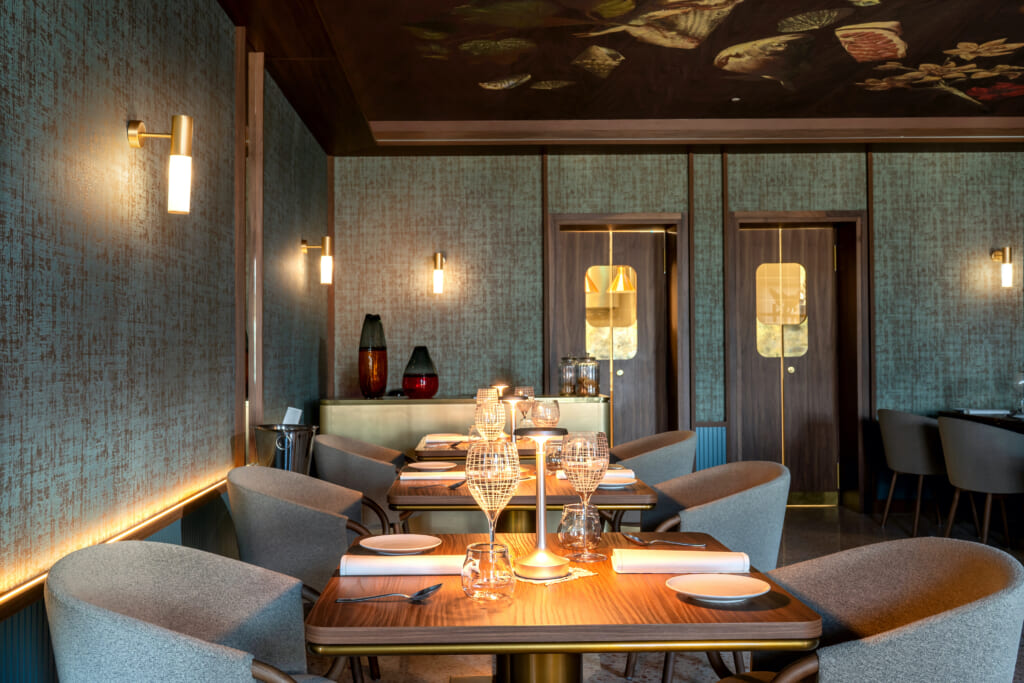
Of course, food and drink are a vital part of the Ca’ di Dio experience, and something Mercier is equally passionate about. Breakfast, with its burgeoning buffet of delectable items and additional specialities available à la carte, is served in the Essentia restaurant. Guests can choose to eat in the courtyard shaded by mimosa trees in the warmer months.
And VERO is the hotel’s fine dining restaurant, which has quickly earned a reputation as one of Venice’s very best. It overlooks the waterfront with a view of the Venetian lagoon and the Island of San Giorgio Maggiore, and also has outdoor seating on the hotel’s expansive front terrace.
Overseen by talented Chef Raimondo Squeo, the cuisine on offer is called “Respectus,” “inspired by typical local dishes and skillfully reinterpreted in a contemporary key, while respecting the seasonality of the ingredients” grown locally and in the private garden in one of the hotel’s courtyards.
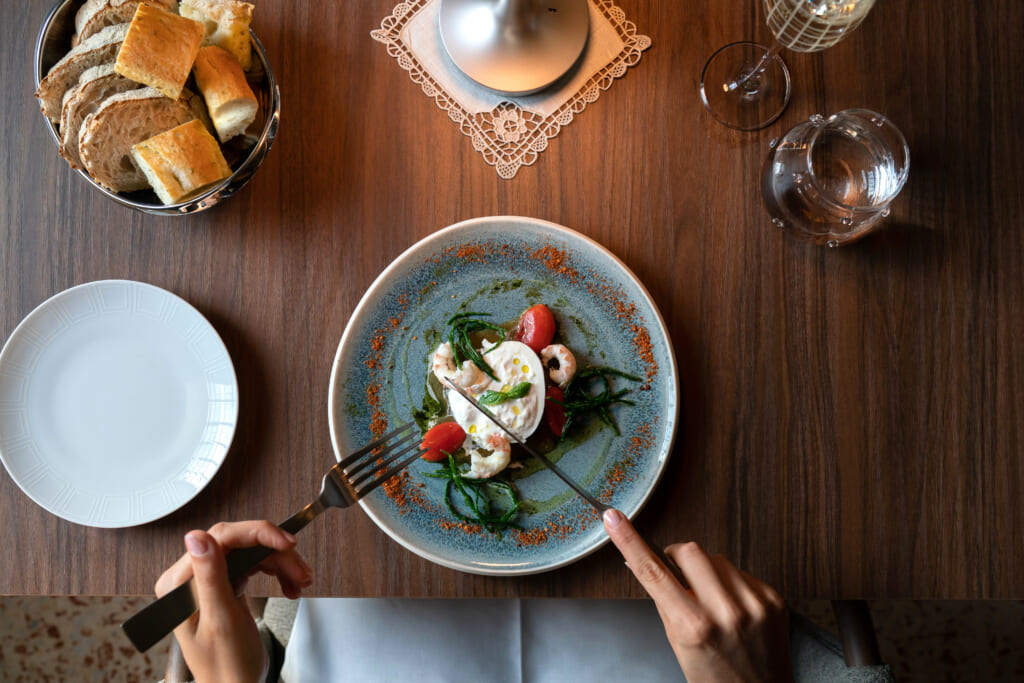
Indeed, everything at VERO starts with seasonality. Ca’ di Dio and Chef Squeo aim to “give guests an authentic experience, rich in history, places and people, where the customer is at the center of everything. It is respect for traditions, respect for products, fragrances and flavors; it is a cuisine with decisive, truthful flavors, based on the quality of the raw materials and enhanced by the technical skills acquired through experience and constant research.”
The use of local products is enhanced with “defined, decisive, authentic and balanced tastes,” and cooking techniques have been simplified as much as possible “so as not to lose the true essence of the products.”

Everything the restaurants serve is homemade, from bread made with natural yeast and stone-ground organic flours produced in the Veneto region, to fresh pasta, artisanal cheese, choice meats from the Montello and Alpago regions, vegetables from Sant’Erasmo, and fish from the Ventian lagoon.
Most vegetables are grown in-house, as are herbs and other ingredients. As an example, one of the most delectable starters is a slow-poached “mountain egg” with chickpea flan, baby spinach, black truffle, and a mousse made from Parmigiano Reggiano cheese aged for 48 months.
Of course, the wine list is spectacular, with Mercier, Squeo, and the head sommelier selecting hard-to-find and local vintages that offer perfect pairings for an evening of innovative and elegant dining.
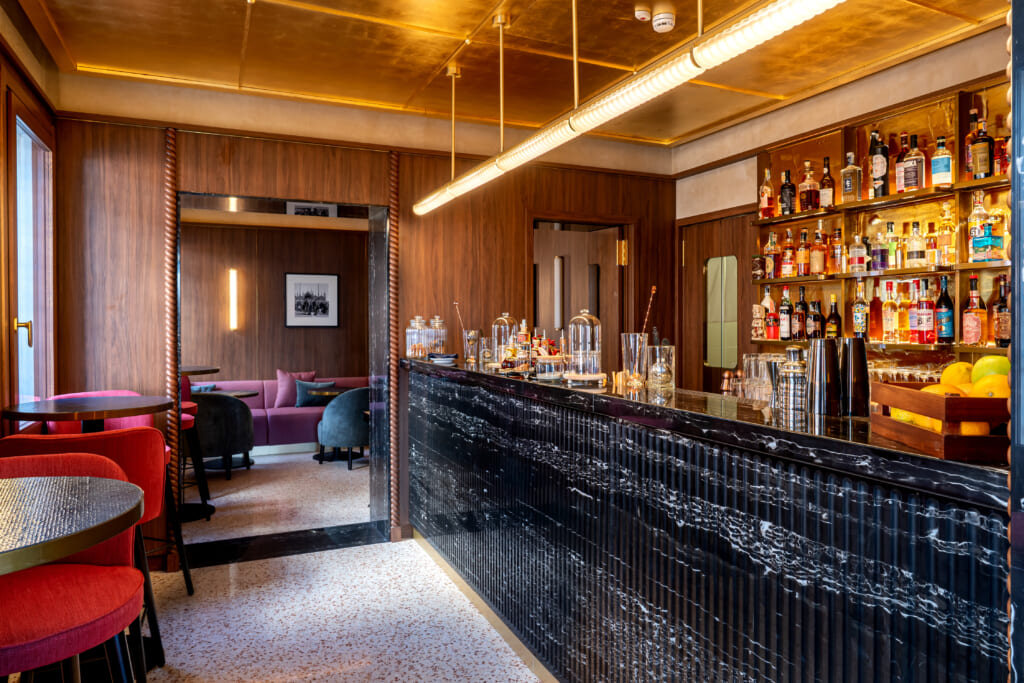
In the inner rooms of the historic building you will also find the Alchemia Bar, which is indeed a temple of alchemy and mixology. While an Aperol or Select spritz is the preferred drink of most visitors and Venetians, especially in the warm afternoons on the terrace, it can be difficult to find more complicated concoctions created by true masters of their craft.
At Alchemia, while of course classic cocktails are available, many of them have been reinterpreted by the hotel’s expert barmen, who use a wide range of botanical and herbal ingredients, sourced specially for the hotel and laid out on the bar as in an ancient apothecary. The barrooms themselves are a cozy jewel box, while drinks and carefully selected small plates are also served on the terrace outside.

Of course, this being Ca’ di Dio, the hotel has its own exclusive line of gin, made adhering to the Respectus principles. Gin al Sale is a “result of the dialogue and exchange between the botany of the Venetian lagoon, the light air, and the crystalline mountain water” in the Dolomites above the city.
It’s a collaboration with Florian Rabanser of Zu Plun, a master distiller who lives at the foot of the Dolomites, a true stickler for authentic flavors and natural ingredients. And of course the bottles are beautiful, handblown by the masters of the LP glassworks in Murano. Bottles of the bespoke gin are available for guests to purchase and take home as a memento or encouragement to essay some elevated mixology at home.
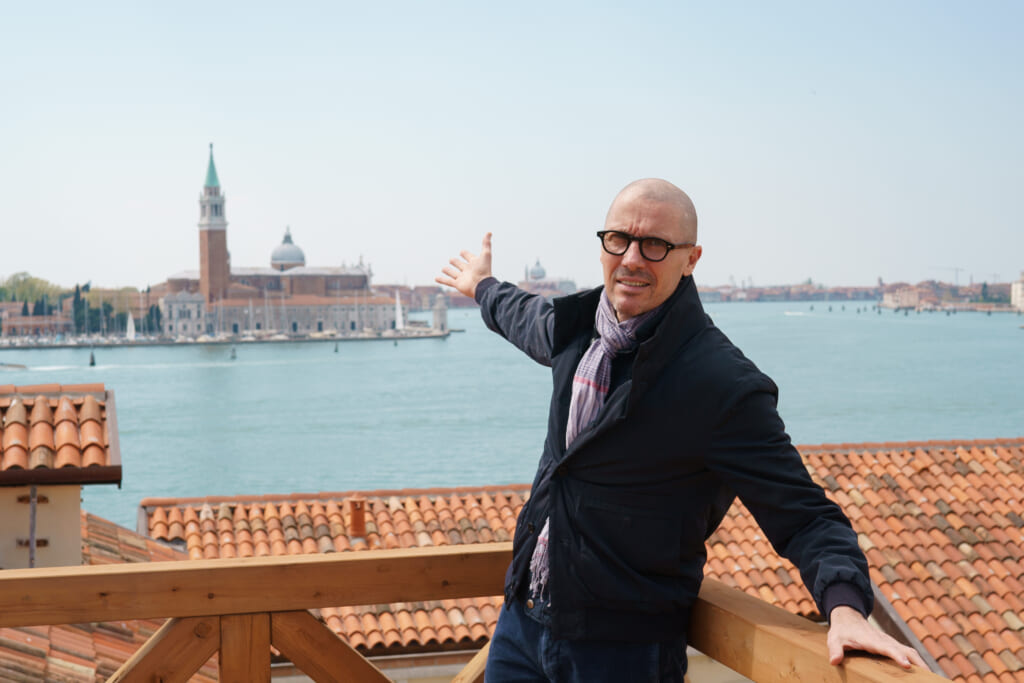
Ca’ di Dio is a member of of the Small Luxury Hotels of the World (SLH) network, a collection of more than 500 small, independently-owned, exclusive hotels in more than 90 countries, known for their elegant accommodations, award-winning spas, and acclaimed dining venues, each one utterly one-of-a-kind.
For SLH, Ca’ di Dio’s emphasis on sustainable luxury is one of its most important features. “Ca’ di Dio is the answer to staying sustainably in a city beset with over-tourism,” says Daniel Luddington, SLH’s VP of Development. “The hotel is unique and innovative in its approach. We’ve recently added it to SLH’s ‘Considerate Collection’, a community of actively sustainable luxury hotels going the extra mile, proving that luxury is compatible with longevity.”
Whatever your reason for visiting, this is one experience that you’ll never forget, from the moment you step off the water taxi to the final nightcap at Alchemia, and everything in between.









